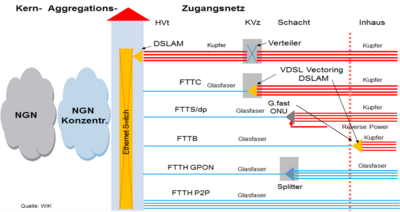Since only consisting of classical copper wires the former telephone access network experienced significant changes. We now face the challenge of a multi year lasting migration from the copper to a fibre access network, causing many implications on the networks themselves but on the services offered and the competition in the telecommunication market too.
This report starts with the coming up of broadband transmission networks as start point of today’s networks. Then we define Broadband networks according to its different capabilities including the definition of VHCN (Very High Capacity Network) of the European Commission and the European Code of Electronic Communications (EECC), which certainly is not the end of future technological development.
The report focusses on the existing and medium term future technologies for access to the fixed network and its relevant characteristics, finally being summarised in an overview table. In addition the report touches the different and important economic and regulatory dimensions of the access networks. Additionally it also refers to comprehensive literature and reports and a recent study of WIK.



![[Translate to English:] Dr Gabriele Kulenkampff](/fileadmin/_processed_/3/3/csm_Gabi-Kulenkampff_195c6a15d3.jpg)